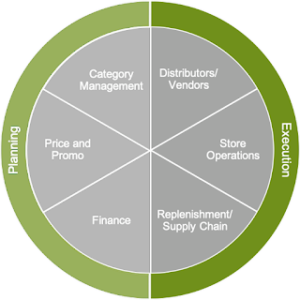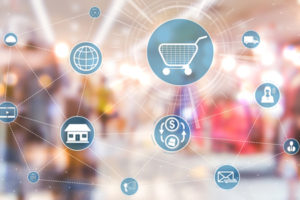
Digging DEEP: Achieving Omnichannel Resilience

Digging DEEP: Achieving Omnichannel Resilience
Earlier this week, Sam Iosevich and Marty Anderson participated in a virtual networking event hosted by Parker Avery partner Synoptek, a global systems integrator (GSI) and managed IT services provider (MSP). This invitation-only, private event was titled, “Reimagining Retail in 2020 and Beyond: Strategies To Modernize, Adapt and Weatherproof Retail Operations,” and included break-out sessions including:
- Delivering a world-class omnichannel retail experience
- Leading with an efficient supply chain to optimize your business
- Improving the shopping experience with AR/AI
- Reducing risks by managing your inventory effectively in the age of COVID-19
- Understanding who is coming into your store through thermal sensors
- Strategic expansion through mergers
- The evolving modern e-commerce platform
- Demand analytics
According to Marty, “The event was a fast and fun way to meet many retail leaders in a short period to assess support needs and potential partnership compatibility. Imagine virtual a ‘speed-dating’ event if you will. We had approximately 8 minutes with each leader to introduce ourselves and our offerings and listen to what they are currently working on, as well as where they may need partnership for future projects. We were also able to meet many new retail leaders of business models that we normally haven’t had exposure to through our normal networking channels. I’m looking forward to following up with some of these leaders to discuss further their business challenges and how Parker Avery can help move them forward.”
This week’s blog is a transcript of the keynote Parker Avery delivered during the live event.
Normally when we talk to companies about resilience, it’s focused on achieving stronger personal resilience throughout their organization. This is such a critical skill set because personal resilience allows you to keep your productivity high during times of stress or disruptive change. We normally approach this by first giving a quick diagnostic to each person to determine their innate flexibility with ideas or adaptability with more or less structure. Then we counsel on ways to engage by leading with their strengths and building awareness of areas for growth and improvement. We encourage them to experiment and be proactive by trying new innovative ideas to solve business problems during times of ambiguity. Partnerships and/or mentorships are always encouraged to learn new ways of coping and managing through disruption.
Building resilience within your omnichannel business should follow very similar steps. You first must identify where you have gaps in either your business process or technical capabilities. Use this information to engage your cross-functional organizations with an improvement roadmap that is prioritized based on value and impact on your business. Find ways to test and learn and move forward as quickly as possible to deliver continuous improvement over time. Stay proactive. Find the right partners to help you on your journey. You may need consulting partners to help you with your assessment and building your roadmap, as well as software and implementation partners to deliver new and modern technical capabilities.
Since March, the retail market has been more volatile than ever before due to the impacts of the COVID-19 pandemic and how it has dramatically limited and/or changed customers’ shopping behavior and service expectations. Even well-established businesses have struggled to stay relevant, essential, and most importantly accessible. There are many concerns and/or opportunities that still need addressing to help businesses recover and stay strong throughout this disruption.
However, the two most prominent challenges that have been consistently on our clients’ minds have been
- Addressing customer accessibility through up-to-date omnichannel capabilities in order to meet customer demand across multiple channels and delivery options; and
- Creating a predictive demand signal that can react faster and more accurately in a volatile sales environment where history is less relevant than the current trend.
Omnichannel Capabilities
While we know that e-commerce has been growing in importance for years, recent events pushed omnichannel and supply chain demands faster than ever. Between March and August of 2020, analysts have attributed over $100B in additional e-commerce sales to the impacts of COVID-19 on our retail industry. It is critical that every business assess its current omnichannel and supply chain capabilities and build a strategic roadmap for where you must position your company to be more adaptable to this type of disruption in the future. Ask these questions:
- Do you have a multichannel selling strategy that provides a consistent quality experience to your customers?
- Do you utilize search engine optimization capabilities?
- Do you offer a high-quality mobile experience?
It’s now more important than ever to meet your customers where they are, which should include a strong mobile strategy and multiple ship/pickup options. Over 54% of all e-commerce sales are completed with mobile devices—even though mobile conversion rates are less than half of the desktops’. This is in part because half of all customers abandon a site if loading takes longer than three seconds. Therefore, some companies are utilizing progressive web applications (PWA) combined with an accelerated mobile page (AMP) to ensure better performance and conversion rates. This is so important because less than 75% of American households have home computers, yet 96% of them have cell phones with over 80% being smartphones.
Demand Analytics
The other major capability that we see companies scrambling to add or improve is demand analytics. Right now, the demand signals that many companies have depended on for years are proving unreliable in the current retail climate. Whether it’s due to forced brick-and-mortar closures due to quarantines or lower traffic patterns due to health concerns, when and how customers are shopping has changed dramatically in a short period of time. These changes make it increasingly difficult to predict where your demand will be and how high (or low) it could be week-to-week. These patterns are still changing and adapting at different rates across the country and the globe.
The best way to get in front of this problem is to have an effective demand analytics strategy that is AI-enabled to ensure it can react and adapt to changing trends quickly and accurately. However, really optimizing this capability will require you to enable a cross-functional demand signal that can be utilized across multiple processes throughout your organization. This improves consistency throughout your end-to-end processes while managing all the way through a product’s lifecycle. Remember, whether you are trying to build a strategic financial plan, determine inventory flow needs, or decide where and when to take markdowns, it all starts with understanding current and future customer demand.
By building these signals with a centralized statistical approach, you reduce variability and improve both accuracy and efficiency across your organization by providing one version of the truth. Remember, you can’t fully optimize your omnichannel sales if you’re struggling to predict where your demand will be by channel.

These two critical capabilities have far-reaching impacts across your operations. Let’s explore these further.
Inventory Management & Supply Chain Optimization
If we have learned anything from the pandemic’s effect on retail, it’s that managing inventory and producing dependable predictive analytics are critical capabilities to staying flexible and meeting consumer demands without risking wasted inventory. Make sure you have the ability to plan by channel and create optimized assortments by location. Examine your order fulfillment capabilities, and ask questions like:
- Do they utilize statistically driven demand signals?
- Do you establish product lifecycle expectations and apply them when choosing how and when to replenish and/or markdown items?
Our supply chains have also been challenged to discover new ways to receive and ship goods on shorter windows and with greater agility, all while maintaining or reducing costs. This year we’ve seen product shortages due to rolling production shutdowns across the globe as well as a stream of cancellation requests due to diminished demands. Building a resilient supply chain is critical to ensure you are agile and scalable to growing and changing demand [a recent Parker Avery podcast episode focused on supply chain resiliency].
Diversification and efficiency are key, so think about all your inventory-carrying locations as ship and pickup points including your brick-and-mortar stores. Customers want more fulfillment options—and they want it free—so effective order management and WMS accuracy are crucial to keeping costs low and shipping times short. According to Shopify, 65% of retailers are moving to same-day delivery offerings, and it’s quickly becoming the norm.
The Store Experience
While e-commerce is growing rapidly in both volume and importance, brick-and-mortar locations will continue to produce 75-80% of total sales. This is still one of the top drivers of customer satisfaction and loyalty, and it’s constantly evolving as well. However, you’ll find that your mobile strategy should include the in-store experience too. Especially now when customers want to feel safe and look for things like contactless checkout or using mobile apps for payment. Also, the ability to identify your customers as they enter your store with your mobile apps and offer individualized promotions or product recommendations is a great advantage. Just make sure the personal offerings are meaningful and relevant to them—otherwise messaging will become more annoying background “noise” and you risk having customers opt out of notifications in the future. Using thermal scanning to check temperatures or build heat maps of traffic patterns can also be used for either strategic product placement decisions or for focused cleaning/sanitation to keep customers safe and healthy.
New innovations in augmented reality (AR) supported by AI are starting to have real impacts on certain markets. These capabilities could include 3D mapping to assist with product location for a grocery store or using photo imaging to virtually try on eyewear or cosmetic products. Ikea and Wayfair are currently promoting applications that allow consumers to scan and measure spaces in their homes and then produce 3D imaging of furniture pieces so consumers can get a feel for how selected furnishings look and feel in their personal space before they buy. These advancements will drive customer confidence, flexibility in the shopping experience, and reduce the risk of returns.
Final Word
While companies may be in different starting positions with different strengths and/or opportunities, just remember to go DEEP.
- Take the time to assess and Diagnose both where you lead with strength and where you need to improve to stay competitive and essential to your customers.
- Engage by building a robust multi-year roadmap that is prioritized by the greatest foundational need or benefit opportunity to keep you focused.
- Experiment and learn from your mistakes quickly. The current disruptions have taught us that we can accomplish great things quickly under duress, which means we can also do it when we have the luxury of more time. Fail fast, adjust and keep moving forward.
- And most importantly, build the right Partnerships to ensure your success. Some organizations may need partners to help diagnose and build a roadmap, while others may only need support with implementation and execution. Either way, establish those relationships early to avoid rework and slowdowns. The right partnerships can get you going faster and keep you on track longer.





